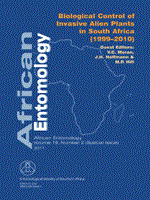The biological control programme against Prosopis species (Fabaceae) (mesquite) in South Africa has reached a stage where the already-established agents, Algarobius prosopis (LeConte) and Neltumius arizonensis (Schaeffer) (both Coleoptera: Chrysomelidae: Bruchinae), are considered to be inadequate. Other potential agents have been identified, including nine beetle species, four moths and a gall midge. Of these, a straight-snouted weevil, Coelocephalapion gandolfoi Kissinger (Coleoptera: Brentidae: Apioninae), whose larvae attack seeds within green pods, is considered especially promising and has been subjected to host-range tests. The biology, ecology and host range of a flowerbud galler, Asphondylia prosopidis Cockerell (Diptera: Cecidomyiidae), have also been investigated. Some pathogens have been considered, as either classical biological control agents or as mycoherbicides. Ongoing debates about the relative value and costs of the trees continue to hamper progress with the planned escalation of biological control. Recent assessments show that the costs of mesquite will soon outweigh the benefits in most situations, opening opportunities to clear additional agent species for release. The results of studies since 1999 on the established and the prospective agents on mesquite are reviewed, while considering the issues that need to be addressed to enable the biological control programme to proceed.
How to translate text using browser tools
1 August 2011
Biological Control of Mesquite (Prosopis Species) (Fabaceae) in South Africa
C. Zachariades,
J.H. Hoffmann,
A.P. Roberts
ACCESS THE FULL ARTICLE
It is not available for individual sale.
This article is only available to subscribers.
It is not available for individual sale.
It is not available for individual sale.

African Entomology
Vol. 19 • No. 2
August 2011
Vol. 19 • No. 2
August 2011
Apioninae
Bruchinae
Cecidomyiidae
invasive alien trees
pathogens




